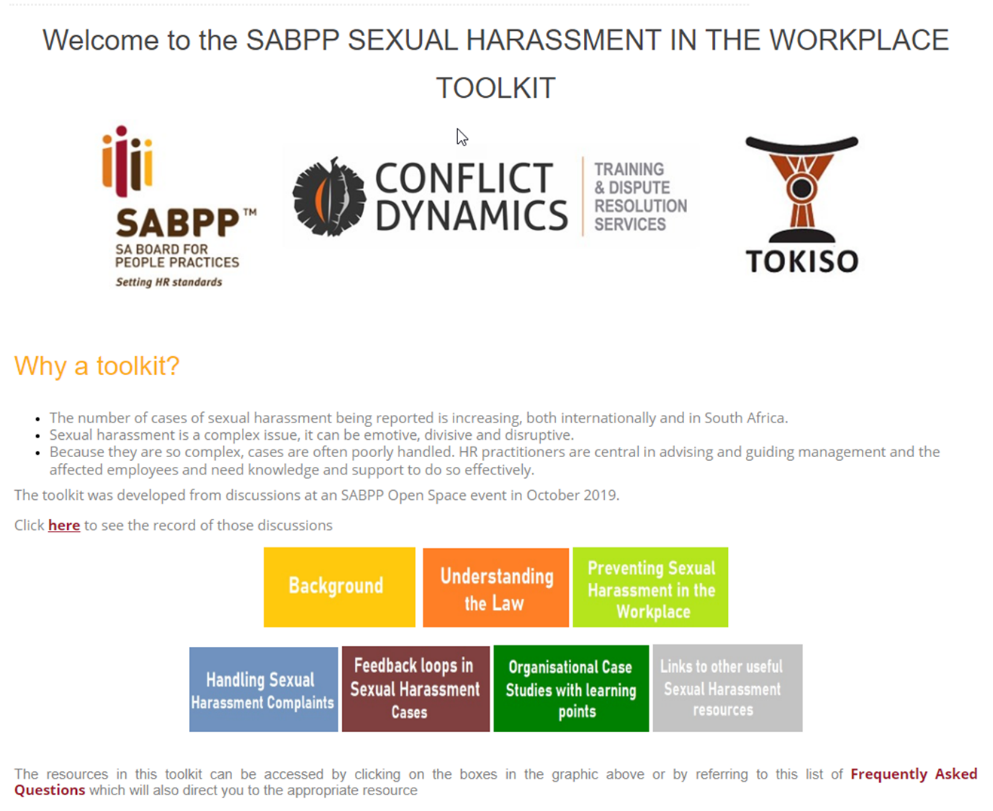Gender-Based Violence And Sexual Harassment

As we mark the 16 days of activism and the 5 days of national mourning for those who died of Covid19 and gender-based violence, we as HR practitioners must once again reflect that sexual harassment in the workplace is a form of gender-based violence. So, the extent to which we can create an organisational climate which does not support any form of harassment can support a better general societal attitude towards gender-based violence.
This is not easy, as the contributors to the 2019 SABPP Open Space Event on Sexual Harassment explored. All too often, poor handling of sexual harassment cases by HR practitioners contributes to a climate of fear and mistrust. The issues involved are often highly complex and HR practitioners have to develop a considerable body of knowledge, skills and wisdom in order to manage cases well.
This is where the Sexual Harassment toolkit of the SABPP can make an important contribution. Available through the website, free of charge to all members, the comprehensive toolkit can be accessed through the Virtual HR tab on the website or using this link: Sexual Harassment in the Workplace – Toolkit – SA Board for People Practices (sabpp.co.za).

One important issue which came out from the development of the toolkit materials was how critical it is to have both a formal and an informal method of dealing with sexual harassment complaints, as required in the Code of Good Practice. Many employers, anxious to emphasise a Zero Tolerance approach, allow themselves only to follow a formal route through grievance to discipline, rather than allowing for informal mediation or other methods. Allowing the use of informal methods can greatly help to overcome employees’ reluctance to come forward to report incidents. There are several articles ANgin the toolkit to assist in understanding and implementing informal methods.
To demonstrate how this can help, consider the situation where an employee comes to HR in confidence regarding another employee making sexual remarks at her. The person complaining about the remarks does not want the other person to get into ‘serious trouble’ and asks that it be kept confidential The company views sexual harassment in a very serious light in which ever shape or form it presents itself and its policy only allows for a formal route, so the HR practitioner has to institute a disciplinary charge against the alleged perpetrator and though doing this breaks the complainant’s request for confidentiality and a low key approach.
An alternative approach is to follow the Code of Good Practice and allow complainants to choose an informal method of resolving the problem. Under this scenario, the HR person can say to the complainant: “I’m so sorry that this has happened and I can understand that you want to keep it confidential, but we have such a firm policy in this regard that I am going to have to ask you please to allow me to deal with it. You are clearly distressed by this behaviour and it is important that we make sure that he understands that his behaviour is unacceptable, and we also have a duty of care to our other employees to make sure that he is not doing the same thing to other people. If you would prefer, we can deal with it informally, which could maybe allow for you to stay anonymous, we could do something like mediation with the perpetrator to make sure he understands how serious this is and doesn’t do it to anyone else. Then, if you are satisfied and accept the outcome, we can simply place a note in his file and the matter will end there, unless he transgresses again in the future.”
Members are encouraged to engage with this issue and other related complexities by referencing the toolkit. We have initiated a Sexual Harassment Special Interest Group under the auspices of the SABPP and hope to be able to convene a virtual meeting some time in the early part of 2021.
Dr Penny Abbott and Dr Angela du Plessis